Genre: Platformer Developer: Taito Publisher: Taito Players: 1-2 Released: 1990
Ah, those innocent childhood years. Where everything seemed fine and the world was colorful. Where arcades were little islands of joy, and not conceived as seedy dens of violence. Back in the mid-eighties, there was this well known little game, a tale of two boys who were turned into dragons and had to defeat monsters in ninety-nine mazes by blowing bubbles. Its cutesy looks and the addicting gameplay made it one of the arcade’s most memorable games ever: Bubble Bobble is one of the classic games of the eighties. The controls were simple and easy to learn, the graphics cute, and the gameplay challenging. I guess everyone over the age of twenty had a go at this game! But as it often goes in the gaming world, when someone is particularly successful, people tend to overlook other members of the family who are at least as worthy. So let’s have a look at Bubble Bobble’s little brother.
At first glance, it seems that even though the game is named Rainbow Islands Extra, the two have next to nothing in common, besides the cuteness! Instead of a pudgy little dragon blowing bubbles at monsters in a maze, our hero now is a pudgy little kid shooting rainbows while trying to reach the top of the levels. The graphics are still very simple, and cuteness prevails. The name is program; the colors of the rainbow are the defining main theme that you will encounter in the graphics, as well as in the theme: As your big-eyed kid is shooting rainbows at big-eyed, cute opponents, you’ll even hear music derived from “somewhere over the rainbow.” Cuteness prevails! But let’s not dismiss this game too easily. Yes, it seems childish. Yes, it is very kid-friendly. And the basic controls (utilizing two buttons: A shoots rainbows, and B jumps) are very simple. But even though it’s a game that every child could play – this game is not child’s play! Far from it.
The controls are learned pretty quickly, and the first few times you play the game, you’ll probably rush through the first few stages in no time. Only after a while, after a few stages, one starts to realize that this game goes far deeper and has much more to it than just a kid shooting rainbows.
The rainbow reaches only a short way, and produces a little arc. This is utilized in a number of ways: First and foremost, it is used to bridge gabs and to climb higher into the level, so you have to shoot rainbow bridges in order to advance. Second, the rainbow is your weapon, and it’s more versatile than you might initially think. You can either directly hit an enemy with it, you can trap an enemy underneath it and hinder its movement, or you can let the rainbow collapse and take any opponent standing underneath with it, creating chain reactions along the way (robbing you of your previously erected bridges in the process, of course). Thirdly, it is your best – and only – means of defense, since you can use it to deflect projectiles some enemies might shoot at you. The more you play the game, the more you realize that it becomes very how you utilize the only tool you have in this game.
And then there are the power-ups: Similar to Bubble Bobble, every time you defeat an enemy, it leaves something behind. This may be simply fruit granting bonus points, a diamond (collect seven different ones for an extra life) or a variety of power ups that is far wider than initially presumed! Certain power ups only appear after a certain condition is fulfilled, and you can play the game a dozen times and suddenly stumble upon a previously unknown bonus ability. And yet, behind every singly power up there’s a method, a certain way of gaining it. Finding out these little secrets is what actually makes most of the fun of this game.
Collecting the diamonds not only grants you an extra life – to get to the true ending of the game, you have to collect all seven different diamonds on all seven islands first. Diamonds can appear after an enemy is defeated, and figuring out how to make which diamond appear is a puzzle in itself. And once you’ve figured THAT out, you realize that if you pull it off correctly you can even skip the boss battles at the end of each level…
Granted, the graphics are very childish, and hopelessly outdated; they look more like they belong to an 8-bit-game. And the sound isn’t all that impressive, but it fits the the mood of the game, adding to the childlike innocence it possesses. This all is more than made up by the enormous depth this game possesses, and all these details make Rainbow Islands such an enjoyable experience. Taito even went so far as to give each island a specific theme, and threw in some of its other arcade creations into the mix. One level is styled like the game Arkanoid, and the opponents of another are taken from the Darius series. Should you manage to reach the very end, you’ll even discover the real tie-in this game has to Bubble Bobble!
This game was a decent hit in the arcades, and enjoyed very high popularity on Amiga and Atari computers. It was also ported to the Master System and the NES. Sadly, for whatever reason, the Genesis version never left Japan! It’s hard to understand why; it’s a great game, and it was very popular on other systems (at least in Europe), and the Genesis incarnation plays great! Played on an U.S. or European console, you even get English screen texts (whatever little text there is)! Still, Sega apparently saw no reason to distribute this title outside of Japan. So this little game about rainbows and diamonds became in itself a colorful, rare and precious gem, whose colorful innocence will always appeal to that little child inside of me.
SCORE: 8 out of 10

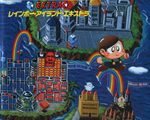
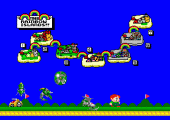
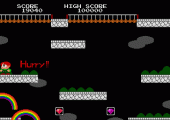
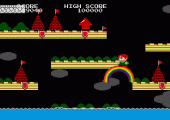
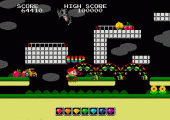
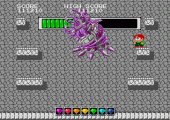
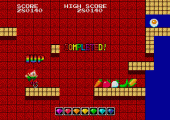
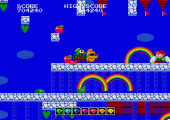
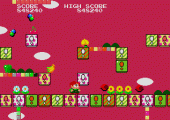
Recent Comments